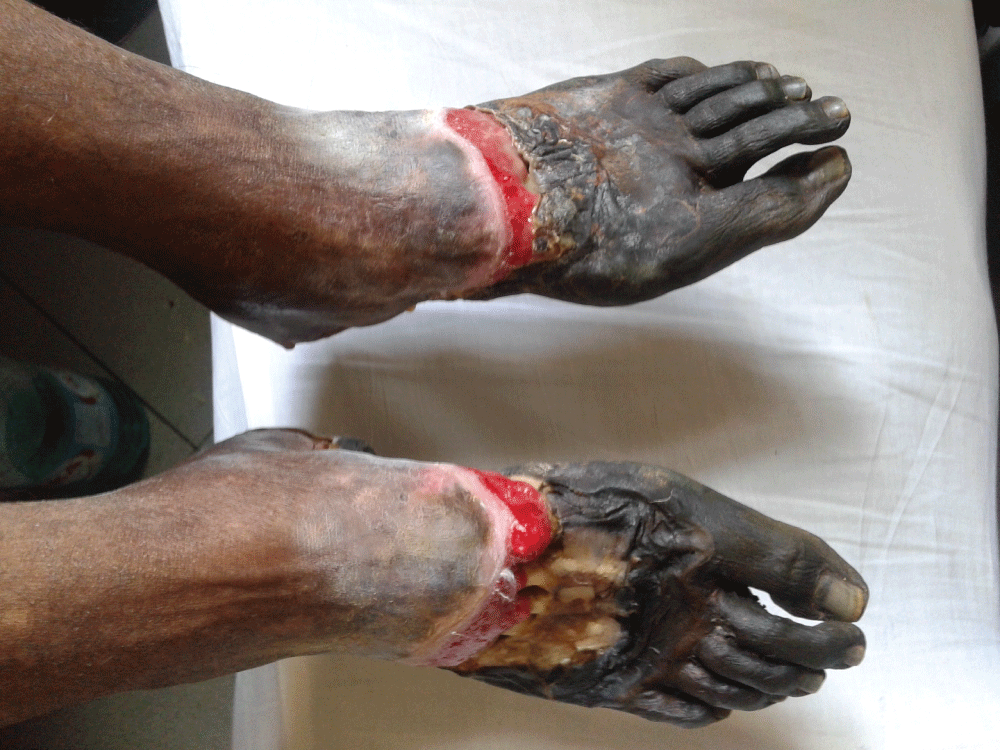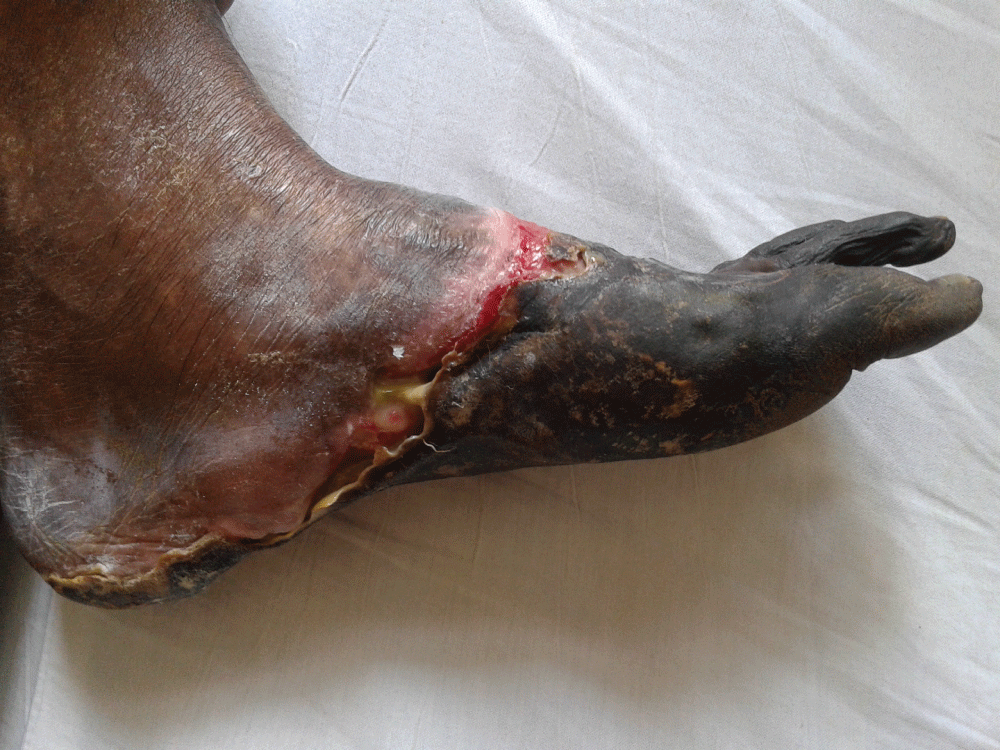Journal of Rheumatic Diseases and Treatment
A Case of Malignant Malaria Complicated By Symmetrical Peripheral Gangrene
Amira A Shahin*, Noha M Abdelbaky and Sahar S Emam
Department of Rheumatology and Rehabilitation, Faculty of Medicine, Cairo University, Egypt
*Corresponding author: Prof. Amira A. Shahin, Department of Rheumatology and Rehabilitation, Faculty of Medicine, Cairo University, Cairo, Egypt, E-mail: amirashahin@hotmail.com
J Rheum Dis Treat, JRDT-1-016, (Volume 1, Issue 3), Case Report; ISSN: 2469-5726
Received: June 02, 2015 | Accepted: July 06, 2015 | Published: July 09, 2015
Citation: Shahin AA, Abdelbaky NM, Emam SS (2015) A Case of Malignant Malaria Complicated By Symmetrical Peripheral Gangrene. J Rheum Dis Treat 1:016. 10.23937/2469-5726/1510016
Copyright: © 2015 Shahin AA, et al. This is an open-access article distributed under the terms of the Creative Commons Attribution License, which permits unrestricted use, distribution, and reproduction in any medium, provided the original author and source are credited.
Abstract
Symmetrical peripheral gangrene (SPG) is a rare complication of malaria. The ischemic changes begin distally and progress rapidly to cause irreversible tissue necrosis requiring amputation in almost all cases. We report a case of a 21-years-old female with malignant malaria complicated by SPG. Our treatment regimen includes corticosteroids in addition to the anti-malaria and anticoagulation therapy. Clinicians should be aware of this entity as early recognition can help in reducing morbidity and mortality.
Keywords
Malaria, Plasmodium falciparum, Gangrene, Corticosteroids
Introduction
Malaria is common throughout the developing world, with approximately 200 million cases annually. Ninety-one percent of the 655,000 deaths from malaria in 2010 occurred in Africa and these were largely due to infection with Plasmodium falciparum [1]. Plasmodium falciparum, the causative agent of malignant malaria, is among the most severe human infectious diseases [2]. The World Health Organization (WHO) has established criteria to classify severe malaria. Severe malaria is defined by seven major syndromes: cerebral malaria, severe anemia, respiratory distress, renal failure, metabolic acidosis, hypoglycemia, and coagulopathy [3]. Parasite sequestration associated with a pro-inflammatory milieu is a critical pathogenic mechanism leading to multi-organ dysfunction in P. falciparum malaria [4].
Symmetrical peripheral gangrene (SPG) is a well-documented but rare clinical syndrome characterized by symmetrical distal ischemic damage leading to gangrene of two or more sites in the absence of large vessel obstruction or vasculitis [5]. The exact pathomechanism of the vascular occlusion in SPG is uncertain. However, infective and non-infective etiological factors have been linked with the development of SPG [6].
Case Report
Twenty one years old unmarried female patient from Sudan, not known to be diabetic or hypertensive, presented to rheumatology and rehabilitation department, Cairo University in Egypt by bilateral feet gangrene. Her condition started 3 months before by fever, vomiting and diarrhea where she was admitted to hospital in Sudan. Investigations were done and the patient was diagnosed as a case of malignant malaria. She had severe anemia and received blood transfusion in addition to other medications, after which she started to develop generalized edema and feet swelling, followed by bluish discoloration and progression to gangrene.
By examination, she was hemodynamically stable with pulse 94/min, blood pressure 120/70, temp 37░C and respiratory rate 24/min. No abnormalities were detected on cardiac, chest, abdominal, neurological and articular examination. She showed bilateral extensive symmetrical feet gangrene extending to the heels with distinct line of demarcation (Figure 1,2).

.
Figure 1: Extensive foot gangrene extending to the heel with distinct line of demarcation.
View Figure 1
Her laboratory investigations revealed erythrocyte sedimentation rate (ESR) 55, hemoglobin (Hb) 11g/dl, Total leukocytic count (TLC) 6.9/mm3, platelets (PLT) 357/mm3, normal liver and kidney function tests, normal lipid profile, antinuclear antibodies (ANA) weak positive, anti-ds DNA, antineutrophil cytoplasmic antibody (ANCA), antiphospholipid antibodies, hepatitis markers and cryoglobulins were all negative. The gangrenous part was of bad odor and discharging pus, culture and sensitivity from the pus was done and revealed proteus mirabilis and systemic antibiotic was given with frequent dressing followed by improvement of infection.
Radiological investigations were done in the form of arterial and venous Doppler of lower limbs, abdominal and pelvic ultrasound, abdominal MRI, chest x-ray, echocardiography and carotid Doppler and all were normal.
Although investigations for malaria were done in the form of fresh blood film and PCR for malaria and they were negative, we relied on the diagnosis done in Sudan and the patient was diagnosed as a case of malignant malaria complicated by symmetrical peripheral gangrene. The absence of other manifestations; e.g. neurological and respiratory, helped to exclude other infectious causes of SPG. Treatment was started in the form of I.V. quinine for 2 days, Preceded by one pulse of 500mg, I.V. methylprednisolone, followed by oral quinine at dose of 2 tablets t.d.s for 5 days, together with anticoagulation. For management of gangrene, forefoot amputation was done followed by grafting. By following up the patient after 6 months and after 12 month, she was totally free.
Discussion
SPG is a clinical entity that manifests as acral ischemic damage in two or more extremities without any evidence of obstruction or vasculitis. A low-flow state is commonly present in association with a hypercoagulable vasospastic situation leading to microcirculatory occlusion. The ischemic changes begin distally and may advance proximally to involve a whole extremity [7]. The most common causes of SPG are bacterial infections like pneumococcus, staphylococcus, meningococcus, and streptococcus. Other established causes are falciparum malaria, viral gastroenteritis, paraneoplastic syndromes, malignancies like Hodgkin's lymphoma, ergotism, vasopressors, shock, and decreased level of protein C [8]. The rate of amputation ranges between 70% and 90%, and the mortality rate may be as high as 35% [9].
Plasmodium falciparum malaria is usually associated with the most severe forms of malaria which might be complicated by multiple organ failure [10].
These complicated cases showed evidence of disseminated intravascular coagulation (DIC). The parasites alter the lipid distribution across the red cells activating the intrinsic coagulation and the complement pathways [11] leading to sequestration of the infected erythrocytes in the microcirculation by molecular interactions with endothelial receptors [12]. Mainly intercellular cell adhesion molecule -1 (ICAM-1) endothelial leukocyte adhesion molecule-1 (ELAM-1), vascular cell adhesion molecule -1 (VCAM-1), thrombospondin (TSP) and histidine rich protein (HRP) [13].
It has been reported that symptomatic Plasmodium falciparum infection was associated with a significant increase in VWF (von Willebrand factor) and active VWF levels and a decrease in ADAMTS13 (VWF cleaving protease) activity, resulting in the presence of circulating ultra-large VWF multimers [14]. The blood coagulation cascade is initially activated by the release of inflammatory cytokines, especially TNF-a and interleukin-6, leading to thrombin formation [15].
The management of patients with malaria and micro-vascular thrombosis is limited to the use of anti-malarial chemotherapy, especially Quinine, and occasional use of anticoagulants upon symptomatology of ischemia [16]. We gave our patient one pulse of I.V. methylprednisolone before the Quinine therapy aiming to stop the inflammatory-coagulation cascade expected to occur in DIC event associated with malaria. The challenge comes in identifying this rare, rapidly progressing complication, before onset of ischemia, as anticoagulants are not usually included in the treatment regime of common malaria. The initial nonsurgical approach helps to avoid the loss of viable tissue and gives time for patient's condition to stabilize [17].
Controlling the inflammatory-coagulation cascade, by a limited number of pulse steroids in association with the anti-malarial therapy and the anticoagulation, as reported in the recent article, may help to break the cycle of damage and limit the magnitude of loss.
Conclusion
Severe coagulopathy with peripheral gangrene may occur in severe cases of malaria. When it occurs, it progresses extremely rapidly leading to irreversible gangrene, thereby necessitating amputation. Limited use of pulse steroids in association with the anti-malarial therapy and the anticoagulation may help in controlling the inflammatory-coagulation cascade and may result in a better outcome of the disease.
Acknowledgement
We are thankful to Dr. Mahmoud ElGazzar, Medical Director, Kibuli hospital, Kampala, Uganda, for his scientific help and for supplying us with the I.V. antimalarial treatment.
References
-
(2011) World Malaria Report. World Health Organization.
-
Rich SM, Leendertz FH, Xu G, LeBreton M, Djoko CF, et al. (2009) The origin of malignant malaria. Proc Natl Acad Sci U S A 106: 14902-14907.
-
(2000) Severe falciparum malaria. World Health Organization, Communicable Diseases Cluster. Trans R Soc Trop Med Hyg 94 Suppl 1: S1-90.
-
Berendt AR, Ferguson DJ, Gardner J, Turner G, Rowe A, et al. (1994) Molecular mechanisms of sequestration in malaria. Parasitology 108 Suppl: S19-28.
-
Davis MD, Dy KM, Nelson S (2007) Presentation and outcome of purpura fulminans associated with peripheral gangrene in 12 patients at Mayo Clinic. J Am Acad Dermatol 57: 944-956.
-
Davis MD (2004) Peripheral symmetrical gangrene. Mayo Clin Proc 79: 914.
-
Molos MA, Hall JC (1985) Symmetrical peripheral gangrene and disseminated intravascular coagulation. Arch Dermatol 121: 1057-1061.
-
Kotokey RK, Kaushik BP (2011) Symmetrical peripheral gangrene and neurological manifestations in Plasmodium falciparum malaria. J Assoc Physicians India 59: 449-451.
-
Ghosh SK, Bandyopadhyay D, Ghosh A (2010) Symmetrical peripheral gangrene: a prospective study of 14 consecutive cases in a tertiary-care hospital in eastern India. J Eur Acad Dermatol Venereol 24: 214-218.
-
Gupta A, Dwivedi Y, Saxena AK, Joshi K (2013) Symmetrical peripheral gangrene with Plasmodium falciparum malaria. J Nat Sci Biol Med 4: 262-264.
-
Phillips RE, Looareesuwan S, Warrell DA, Lee SH, Karbwang J, et al. (1986) The importance of anaemia in cerebral and uncomplicated falciparum malaria: role of complications, dyserythropoiesis and iron sequestration. Q J Med 58: 305-323.
-
Sharma BD, Gupta B (2002) Peripheral gangrene in a case of complicated Falciparum Malaria. JIACM 3: 297-299.
-
White NJ (1996) Malaria. In: Cook G. Manson's Trophical Disease, University of London, UK: 1087-1164.
-
L÷wenberg EC, Charunwatthana P, Cohen S, van den Born BJ, Meijers JC, et al. (2010) Severe malaria is associated with a deficiency of von Willebrand factor cleaving protease, ADAMTS13. Thromb Haemost 103: 181-187.
-
Tessier-Marteau A, Cruguel SI, Grand F, Asfar P, Zandecki M, et al. (2009) DIC and peripheral gangrene in a severe Plasmodium falciparum malaria: the coagulation-inflammation cycle with Plasmodium falciparum as a model. Ann Biol Clin 67: 569-572.
-
Losert H, Schmid K, Wilfing A, Winkler S, Staudinger T, et al. (2000) Experiences with severe P. falciparum malaria in the intensive care unit. Intensive Care Med 26: 195-201.
-
Johansen K, Hansen ST Jr (1993) Symmetrical peripheral gangrene (purpura fulminans) complicating pneumococcal sepsis. Am J Surg 165: 642-645.






